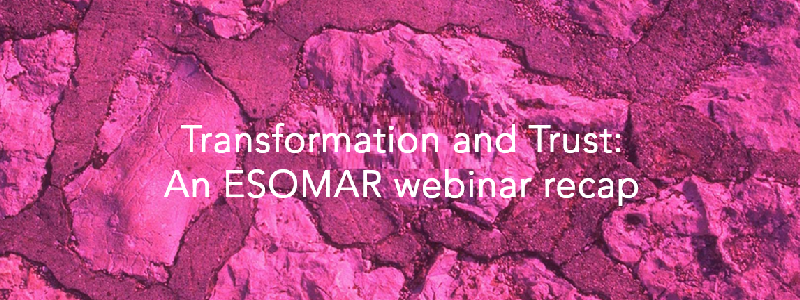
Collision 2021 was a four-day, North American tech conference that drew more than 38 000 attendees. I was fortunate to be one of those attendees this year thanks to a ticket kindly donated by ESOMAR. This year, the Collision Conference hosted more than 600 speakers from all walks of life. Just a few of those people included:
- Celebrities: Cindy Crawford, Meaningful Beauty; Maria Sharapova, Therbody; Ashton Kutcher, Sound Ventures; Ryan Reynolds, Mint Mobile
- CEOs and CMOs from global companies: Geoffrey Hinton, University of Toronto; Ukonwa Ojo, Amazon; Fiona Carter, Goldman Sachs; Martin Wildberger, Royal Bank of Canada
- Local and global community leaders: Jagmeet Singh, Leader of Canadian New Democrat Party; John Tory, Mayor of Toronto; Katie Porter, Representative at US House of Representatives; Lori Lightfoot, Mayor of Chicago
- And 13-year-old whiz kids whose expertise and speaking skills rivaled the most experienced speakers in attendance!
With hundreds of sessions running simultaneously (and literally colliding with each other!), it was easy to create a personalized stream of content, particularly since no matter the time, a great talk was always just beginning. The stream I created for myself focused on artificial intelligence, robotics, and innovation. Here are the key themes I took away.
Technology Leaders Must Prove Their Trust
People love their devices. We trust them to help us discover and buy products, make and take phone calls and text messages from our loved ones, and remind us about confidential meetings and doctor’s appointments. We trust our devices will work as expected when we need them to work. However, there is a trust problem and it doesn’t lie with the technology itself. It lies in the fact that we don’t trust the people behind our devices, neither the people building the devices nor our government leaders, to create and hold appropriate boundaries around privacy and security.
Companies build trust by having clear values and a clear mission grounded in being authentic, empathetic, transparent, and relatable. We learn to trust companies that shape our experiences in ways that are personalized but at the same time not creepy. We also learn who trust by witnessing which companies hold themselves fully and immediately accountable when they make mistakes. Companies that abuse these expectations will quickly find themselves speaking to a declining audience. A great way to think about trust is that every interaction a company has with a consumer is either a deposit or a withdrawal. You do good or you do bad. There is no neutral.
Robot, Cobots, and the Inevitable
Did you realize you already have robots in your home? If we follow the strict definition that any automatically operated machine that replaces people is a robot, then your electric toothbrush, your toaster, and your vacuum cleaner (even if it’s NOT a Roomba) are robots. We’re slowly getting used to the idea that robots don’t have to take a human shape to be called robots.
A newer take on robots is the idea of cobots. Unlike a lot of robots that run behind the scenes, collaborative robots are designed to interact directly with or next to people. While you may be nervous that robots or cobots will take your job, there are many good reasons to be excited about working with them. Not only do they easily take on jobs that are dull, dirty, and dangerous, they augment our skills and abilities and help us do our work better and with more agility. Robots make us physically stronger and mentally more agile. If we let them, they help us make truly better decisions.
As in the case of robots and cobots, if something is inevitable, get enthusiastic about it.
The Language of AI
One of the main complaints about artificial intelligence comes when it’s used as a substitute for people. For instance, researchers are actively working on building AI tools intended to serve as personal companions for people who are elderly or disabled, and counsellors for people who’ve experienced trauma. Isn’t that impersonal? Isn’t that disrespectful? Well, let’s consider it from a different angle.
Think about people who’ve experienced a life of trauma, a life wrecked by abuse, trafficking, trauma, or addiction. A life where people have repeatedly let them down and shown that they can’t be trusted. Those who’ve experienced trauma may find it particularly hard to trust new people and may be far more comfortable beginning their healing process by working with AI.
Think about people who have experienced a brain injury or deal with communication disabilities. Or people who aren’t using their native language. Or people who feel more comfortable communicating via email or text. We constantly hear that people should be treated in the way they want and prefer to be treated. That we need to increase accessibility. This could easily be AI.
Regardless of the initial need, we need to ensure that these AI communication tools demonstrate empathy and show respect. AI can’t replace human judgement but it can and should reflect good judgement.
What Does It Mean For Researchers
The research industry talks about trust all the time. We need research participants to trust us enough to share their most personal opinions, their most private click-paths, and their most unusual purchase behaviours. We need research tools that can effectively automate dull and error-prone research tasks leaving us with more time to do our jobs even better and make better decisions.
And we really need to focus on language. So much of our work revolves around language – writing questionnaires with respectful wording that everyone can understand, moderating focus groups that accommodate every participant, making the research space accessible to all.
I may not have attended a single market research talk but I did indeed come away with new perspectives that will make me rethink how I have conducted research in the past, and what I will do in the future.
